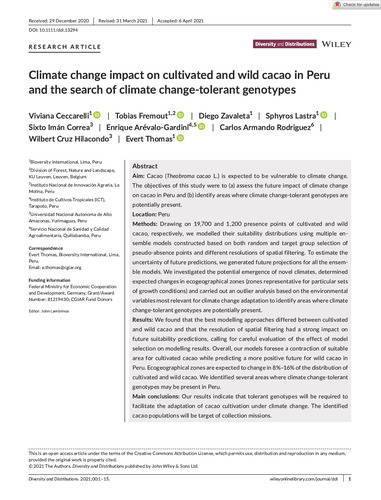Climate change impact on cultivated and wild cacao in Peru and the search of climate change-tolerant genotypes
Aim: Cacao (Theobroma cacao L.) is expected to be vulnerable to climate change.
The objectives of this study were to (a) assess the future impact of climate change on cacao in Peru and (b) identify areas where climate change-tolerant genotypes are potentially present.
Location: Peru
Methods: Drawing on 19,700 and 1,200 presence points of cultivated and wild cacao, respectively, we modelled their suitability distributions using multiple en semble models constructed based on both random and target group selection of pseudo-absence points and different resolutions of spatial filtering. To estimate the uncertainty of future predictions, we generated future projections for all the ensem ble models. We investigated the potential emergence of novel climates, determined expected changes in ecogeographical zones (zones representative for particular sets of growth conditions) and carried out an outlier analysis based on the environmental variables most relevant for climate change adaptation to identify areas where climate change-tolerant genotypes are potentially present.
Results: We found that the best modelling approaches differed between cultivated and wild cacao and that the resolution of spatial filtering had a strong impact on future suitability predictions, calling for careful evaluation of the effect of model selection on modelling results. Overall, our models foresee a contraction of suitable area for cultivated cacao while predicting a more positive future for wild cacao in Peru. Ecogeographical zones are expected to change in 8%–16% of the distribution of cultivated and wild cacao. We identified several areas where climate change-tolerant genotypes may be present in Peru.
Main conclusions: Our results indicate that tolerant genotypes will be required to facilitate the adaptation of cacao cultivation under climate change. The identified cacao populations will be target of collection missions.

